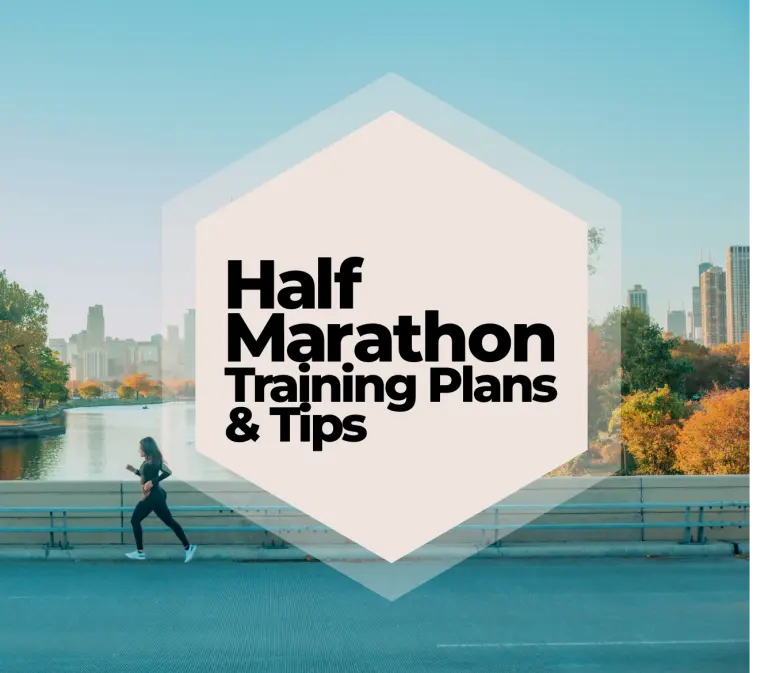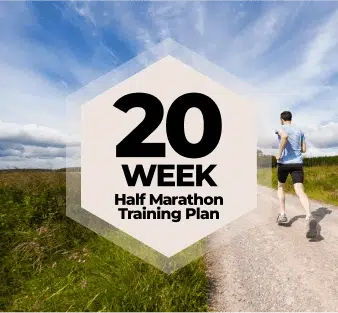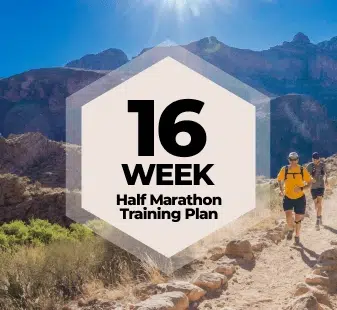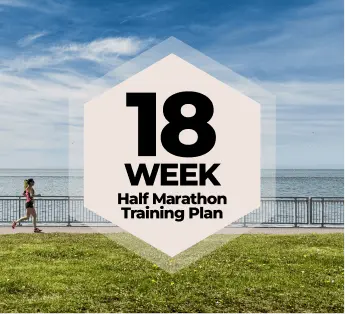So, you want to run a half marathon — but you don’t really run at all right now. That’s okay! You’re in the right place. The good news: With the right plan and mindset, going from zero miles to 13.1 is absolutely doable — and we’ve got the perfect 12-week Couch to Half Marathon training plan to help you make it happen.
This beginner-friendly, zero-experience plan is designed to ease you into running with a safe and steady progression. You’ll start with simple 30-minute run-walk sessions, alternating between short bursts of running and walking. We’ll gradually build your endurance so that, before you know it, you’re comfortably tackling long runs — and yes, even seven miles will feel like no big deal in the not-too-distant future.

Our one requirement: You follow the plan closely. It’s tempting to keep going an extra mile or two when you’re out there feeling good, but running puts unique force and impact on your body and we need to work our way up to being able to handle that load. We’re here to prevent running injuries and maximize gains.
If you’re an older runner or returning to fitness after a break, consider checking in with your doctor or looking into age-specific advice to ensure a smooth start to your running journey. Let’s do this!
Your 12-Week Couch-to-Half Marathon Training Program
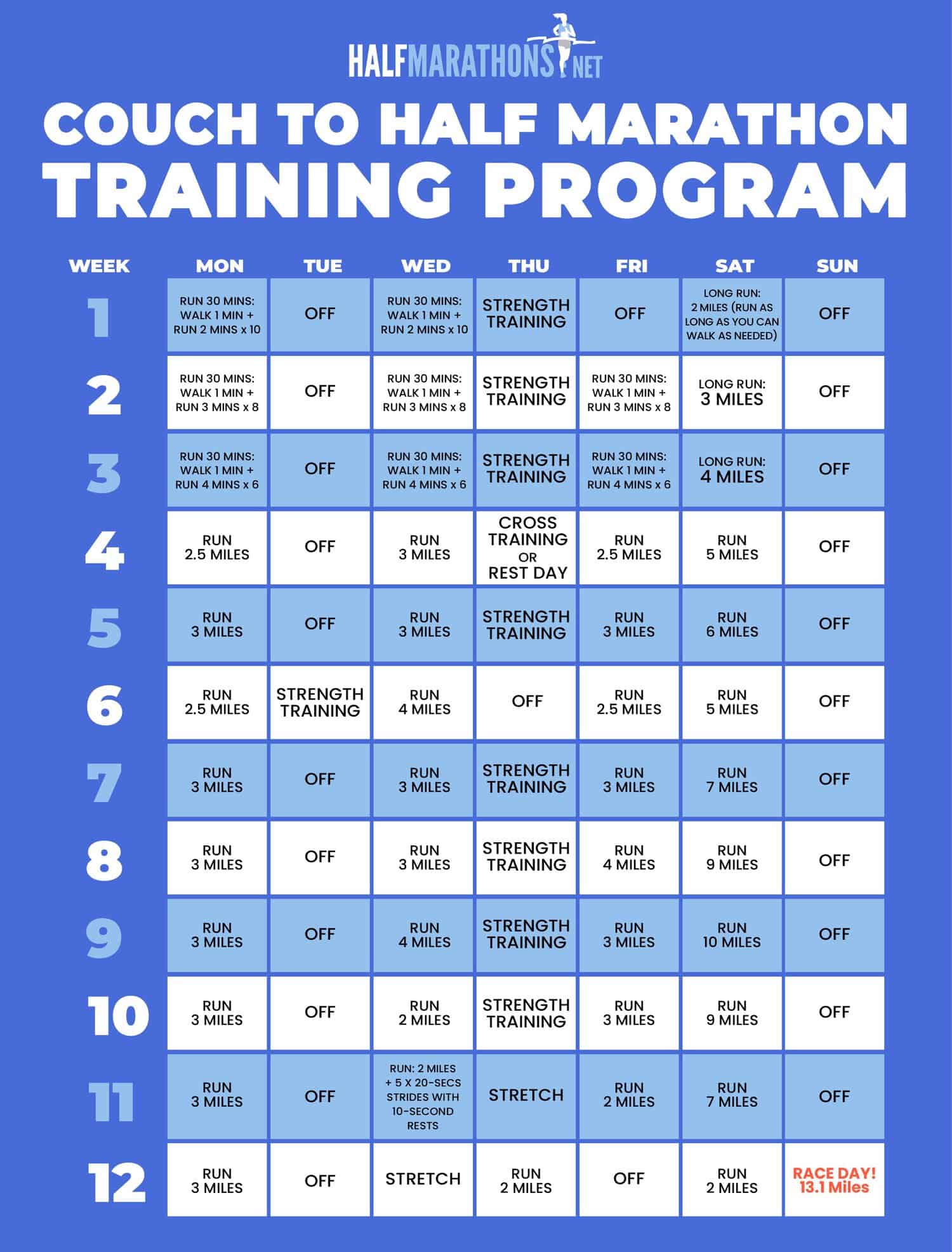
Week 1
The first week of the couch-to-half marathon training schedule is centered around priming your body and mind for the bigger weeks and longer runs ahead. Over years of training, we’ve found the best way to start running is the run-walk method. This allows your muscles and joints time to adjust to the new physical impact stress while developing your aerobic capacity for running workouts.
You’ll also be building overall strength through weekly bodyweight exercise sessions.
Training Schedule
| Monday | Run 30 mins: Walk 1 min + run 2 mins x 10 |
| Tuesday | Rest Day |
| Wednesday | Run 30 mins: Walk 1 min + run 2 mins x 10 |
| Thursday | Strength Training |
| Friday | Rest Day |
| Saturday | Long Run: 2 miles (run as long as you can, walk as needed) |
| Sunday | Rest Day |
Nutrition
Keep in mind that you will be burning more calories than your life pre-running. Half marathon nutrition is everything during training. Here are the basics:
- Keep your energy stores up by maintaining dietary balance and variety.
- Aim for 50% to 60% of your calories to come from carbohydrates. When carbs are digested, they are broken down into smaller sugar molecules called glucose, which is then stored as usable fuel in the liver and muscles. Carbohydrates delay fatigue. It also aids in muscle repair helping protein do its job.
- Aim for 15% to 20% of your daily calories to come from healthy fats.
- Aim for 15% to 20% of your calories to come from protein, which provides amino acids to build and repair muscles. Here’s a formula to figure out how much protein you need:
| I am… | I workout… | My workout duration is… | My protein needs are… |
| Active | 4-5 days per week | Average 30-50 minutes per session | .5 grams of protein per lb of body weight |
| Super Active | 5-6 days per week | Averaging 50 minutes or more per session | .75 grams of protein per lb of bodyweight |
Training Tips
It’s your first week – congrats! Be sure you pace yourself and don’t overdo it. It’s easy to get caught up in the excitement of being able to run further than you thought you could. If you have the stamina to walk less and run more in your intervals, go for it, but don’t increase the overall time or mileage for each training day. Tackling too many miles, too quickly, can cause overuse injuries. We’re here to adapt your body to the new routine slowly.
Week 2
Training Schedule
| Monday | Run 30 mins: Walk 1 min + Run 3 mins x 8 |
| Tuesday | Rest Day |
| Wednesday | Run 30 mins: Walk 1 min + Run 3 mins x 8 |
| Thursday | Strength Day |
| Friday | Run 30 mins: Walk 1 min + Run 3 mins x 8 |
| Saturday | Long Run: 3 miles |
| Sunday | Rest Day |
Nutrition
As your miles increase, so too will your calorie burn. Because the half marathon distance is a beast, training is the time to fuel and not the time to diet. Continue to eat well-balanced, nutrient-rich foods and snacks to keep your energy up – check out some ideas below. Drink water throughout the day to maintain hydration.
Meal and Snack Ideas
- Breakfast: Egg and smoked salmon scramble, side of spinach
- Snack: Carrot sticks and hummus
- Lunch: Black bean and quinoa bowl with zucchini, salsa, and shredded cheese
- Snack: Chocolate milk
- Dinner: Chicken and veggie skillet with brown rice
- Our entire list of recommended meals for runners (with recipes)
Training Tips
In week two, runs will get longer but should still feel manageable. If they are so difficult that you’re gasping for air at the end of each segment, you’re likely running too fast and above your fitness level.
If you don’t have one, you need to get a running watch to see just how fast you’re going. Running apps are also super motivating and helpful with pace. Our favorite running app is Runna. Runna is like having a coach in your pocket providing detailed, dynamic feedback on your training. Readers receive 2-weeks of free training with code HALF.
Next, determine your pace. Use the talk test to gauge how well you are handling the speed. Basically, can you talk at the pace you’re running at? We call this conversational pace. If you cannot sustain conversation for the entirety of your run, you need to slow down. This will ensure you are running within in a good heart rate zone. Going too fast is not optimal for your training and could lead to pain and overuse injuries.
Consider a heart rate monitor. Grab a heart rate monitor or running watch. Getting feedback on your pace and heart rate will help you establish a good training pace.

Week 3
In week three, your running time versus walking time increases. Your long run, too, will likely be the longest you’ve done so far, both in distance and duration.
If you are struggling and need to walk, that’s totally fine. The time on your feet and aerobic exercise is still adding to the training bank.
Training Schedule
| Monday | Run 30 mins: Walk 1 min + Run 4 mins x 6 |
| Tuesday | Rest Day |
| Wednesday | Run 30 mins: Walk 1 min + Run 4 mins x 6 |
| Thursday | Strength Day |
| Friday | Run 30 mins: Walk 1 min + Run 4 mins x 6 |
| Saturday | Long Run: 4 miles |
| Sunday | Rest Day |
Nutrition
This week, your body is probably telling you what it wants and needs. Namely, you might be super hungry. You’re burning a lot of calories and you have to make sure you are addressing your hunger needs.
If you are running in heat and humidity. or if you’re just a person who sweats a lot no matter what, intentionally replenish your electrolytes. Now is the time to start testing out what sports drinks work for you. The best electrolytes for runners have sugar (yes really!) and sodium.
Meal and Snack Ideas
- Breakfast: Whole wheat bagel, cream cheese or butter, eggs
- Snack: Rice cake sandwich with nut butter
- Lunch: Tuna and pita pockets with lettuce
- Snack: Hard Boiled egg with crackers and grapes
- Dinner: Steak fajitas with colorful bell peppers
Our entire list of recommended meals for runners (with recipes).
Training Tips
This is the week to address any pain points before they become worse.
Look for muscle rubs for aches, better socks for blisters, and KT tape for tight muscles. Home remedies are awesome, but if you’re able, add a physical therapist to your training team. They can stretch and massage tight muscles and teach you strength and stretching exercises to complement your running and strength plan.
Make sure you’re not skipping leg day! Strength training for runners is super important to minimize pain and injury risk.
Lastly, celebrate your accomplishments! Sports psychologists say this attitude will keep you in a positive mindset.
Week 4
Your plan no longer has run-walking breaks. You’ve graduated to reaching mile distances. This doesn’t mean you have to abandon the run-walk method. In fact, some experienced runners use run-walking to hit personal bests at races.
Experiment. Determine what pacing strategy works best in order to ensure you’re getting the miles in without the pain.
This week, if you are feeling any aches or tender muscles, swap in a few runs for cross-training days, like biking, hiking, swimming, or walking.
Training Schedule
| Monday | Run 2.5 miles |
| Tuesday | Rest Day |
| Wednesday | Run 3 miles |
| Thursday | Cross-Training or Rest Day |
| Friday | Run 2.5 miles |
| Saturday | Run 5 miles |
| Sunday | Rest Day |
Nutrition
Your distances are getting longer, so it’s time to pay attention to meal and snack timing – especially on the days of your long runs.
On long run days, eat a light breakfast two to four hours before you begin. Have a light snack 30 minutes before.
If you are going to run longer than one hour, bring some sort of calories with you on the run. You want to eat something 45 minutes in, and then every 30 minutes or so. This can be:
- Sugary gels
- Sports jelly beans
- Honey sticks infused with electrolytes
- Gummies
- Sports drinks
Every time you eat, you should take a sip of water.
Starting right now, begin testing these sports foods. Some will not sit right with you, others will taste awful – you need to know what will work for you on race day so there are no bodily surprises.
It’s good to also note that for your short, easy runs, it’s helpful to eat a light snack 30 min before you begin. No weird gels or goos necessary.
Meal and Snack Ideas
- Breakfast: Whole grain toast, two eggs, avocado
- Snack: Apple and nut butter
- Lunch: Big salad with baked turkey, veggies, and crackers
- Snack: Greek yogurt with granola and berries
- Dinner: Grilled chicken, avocado, and brown rice
- Our entire list of recommended meals for runners (with recipes)
Training Tips
Long runs are especially important now not just for training but for figuring out everything about race day. Start planning your half marathon race gear and wear things during your long runs to make sure they make you feel confident, comfy, and chafe-free.
Also crucial: A great playlist filled with the best running songs (usually 160 to 180 bpm).
Week 5
During this phase of the training cycle, the volume is going to increase at a faster rate than before. This is a good time to learn how to control your breathing to keep your heart rate in a steady aerobic state.
Training Schedule
| Monday | Run 3 miles |
| Tuesday | Rest Day |
| Wednesday | Run 3 miles |
| Thursday | Strength Training |
| Friday | Run 3 miles |
| Saturday | Run 6 miles |
| Sunday | Rest Day |
Nutrition
Longer distances will lead to more and more fluid loss.
Bring a water bottle with you even on your shorter runs. Our preference is the Flipbelt water bottle which fits snuggly against your body during a run. Running with a water bottle will get you used to carrying whatever vessel you choose. Hydration when you’re in week 5, is not rocket science. If you feel thirsty, drink something. Let your thirst (and the color of your pee) be your guide. Keep up with your balanced diet and try these:
Meal and Snack Ideas
- Breakfast: Veggie omelet with a slice of toast
- Snack: Protein bar
- Lunch: Turkey BLT sandwich on whole wheat
- Snack: Cheese and crackers
- Dinner: Grilled salmon, sweet potatoes, and asparagus
- Our entire list of recommended meals for runners (with recipes)
Training Tips
Your miles are getting longer, so make sure you’re running with a (filled) water bottle and snacks.
Breathwork while running will be your best friend as training gets harder. It helps set your pace and paying attention to your breath can help you turn inward, notice how your body is feeling, and help those miles go by faster.
Think about it like this:
- Breathe in for three steps, then out for two. That’s your easy run cadence.
- Do a body scan.
- Coach any tired or tight muscles with your mind.
For example, if your feet feel like concrete, and you notice that you can send a message down to your feet to try to take that heaviness away. Send breath down to your feet and repeat in your head “my feet feel light and cool.” Will it work every time? Not every time, but this matched with breathing patterns can really help.
Week 6
You’re halfway through, which means you are six weeks away from the big race! This week will be a bit of a step-back week to give your body time to recover and get stronger to tackle the rest of the plan. Take your rest days seriously!
Training Schedule
| Monday | Run 2.5 miles |
| Tuesday | Strength Training |
| Wednesday | Run 4 miles |
| Thursday | Rest Day |
| Friday | Run 2.5 miles |
| Saturday | Run 5 miles |
| Sunday | Rest Day |
Nutrition
Eat with intention, focusing on foods that make you feel good and that your mind equates with recovery.
Meal and Snack Ideas
- Breakfast: Nut butter and banana sandwich
- Snack: Pickled beets, crackers, and goat cheese
- Lunch: Cobb salad
- Snack: Mozzarella stick and grapes
- Dinner: Chicken stir fry
Training Tips
Your body will be feeling the accumulated miles by this point. This is good!
Think about it this way: At mile 10 during a half marathon, your legs will be tired. You should get used to the feeling of running on tired legs.
Make it a point to notice anything that might be standing in the way of your rest during training. Are you getting a good night’s sleep? Are you spending extra time on your feet when you’re not running? How is your stress level? Finding ways to remedy lifestyle issues that might be causing you more fatigue can be really helpful in getting to the finish line.
- Prioritize sleep. Establish a bedtime routine and make it a goal to get at least seven hours of rest per night.
- Monitor stress. Start a training journal to record any extra activities and your stress level.
- Half-way self-care. Prioritize your rest by meditating, napping, taking a bath – make this a week of self-care.

Week 7
Hopefully your legs will feel fresh-ish and you’ll be ready to tackle some new distance records. We’ll focus on optimizing the long run so you feel ready to go the full half marathon distance.
Training Schedule
| Monday | Run 3 miles |
| Tuesday | Rest Day |
| Wednesday | Run 3 miles |
| Thursday | Strength Training |
| Friday | Run 3 miles |
| Saturday | Run 7 miles |
| Sunday | Rest Day |
Nutrition
On days following long runs, you might feel ravenous. That endless hunger is your body telling your brain that your energy stores are depleted. Plan what you’re going to eat post-long-run the day before..
Meal and Snack Ideas
- Breakfast: Scrambled eggs, turkey bacon, whole wheat toast
- Snack: Protein smoothie
- Lunch: Pasta, white beans, spinach, and sundried tomatoes
- Snack: Spring mix salad with canned tuna, avocado, walnuts, seeds, dressing
- Dinner: Sheet pan flank steak and broccoli with brown rice
Training Tips
Calories, calories, calories. Make sure you are replenishing your calories and fluids.
Connect with your purpose. Long runs force you to mentally reach past your limits and get comfortable being in a new place physically. Don’t get discouraged! Determine your “why” for running and training for this race. Keep asking yourself why the race is important to you, and when things get hard, think about that reason.
Also, add more songs to your playlist!
Train smart. Break it up – think about it, you’re only running three-ish 2.5-mile stretches. Take breaks and get it done!
Week 8
With only a month left until race day, it’s time to start thinking about what your average race pace, or pace per mile for the half marathon, will be. Use an online pace calculator to plug in your easy run pace and it will spit out an approximate race pace. This will just give you a general idea of how fast you should race.
Training Schedule
| Monday | Run 3 miles |
| Tuesday | Rest Day |
| Wednesday | Run 3 miles |
| Thursday | Strength Training |
| Friday | Run 4 miles |
| Saturday | Run 9 miles |
| Sunday | Rest Day |
Nutrition
Week eight is a really good time to start tinkering with your pre-race dinner. Gastrointestinal issues are so common for distance runners but often small dietary changes will fix that poop-in-your-pants feeling.
If your stomach is bothersome, try lessening the amount of veg you’re eating the day before a long run and see if it helps. Watch out for refined carbs and sugars that can also mess with your belly.
Meal and Snack Ideas
- Breakfast: Scrambled eggs with a whole wheat English muffin with butter and jelly
- Snack: Grapes, crackers, and string cheese
- Lunch: Six-inch turkey sub
- Snack: Cottage cheese and pineapple cubes
- Dinner: Grilled chicken breast, baked potato, and a small portion of string beans
Training Tips
Test out your race pace to see if it feels reasonable for 13.1 miles. Run a half-mile of your long run at this pace and see how it feels. Then, slow right back down; there’s no need to run at that pace at this time in your training.
Then forget it. For now. Don’t obsess about it – there is still work to be done!

Week 9
Get ready for your first double-digit long run and first 20-mile week! Getting this far indicates that most of your training is in the bag. You are almost ready for the start line.
Training Schedule
| Monday | Run 3 miles |
| Tuesday | Rest Day |
| Wednesday | Run 4 miles |
| Thursday | Strength Training |
| Friday | Run 3 miles |
| Saturday | Run 10 miles |
| Sunday | Rest Day |
Nutrition
During these high-mileage weeks, many beginner runners start to feel fatigued. Way too often it’s because they are not consuming enough calories. Pay close attention to your calories in vs. calories out and make sure you are not training at a deficit.
Meal and Snack Ideas
- Breakfast: Spinach frittata
- Snack: Wasa crackers with soft cheese and apple slices
- Lunch: Tuna on a whole wheat wrap and carrot sticks
- Snack: Almonds
- Dinner: Sirloin steak, broccoli rabe, and sweet potato
Training Tips
Hitting a 10-mile run is an awesome feeling. To make sure you’re successful, it’s a good idea to prep before you step out the door. To take the guesswork out of it, spend time planning a route. If you are worried about making it through the whole 10 miles, find a running group – your local running store can help you find one.
- Eat enough. No other comments!
- Prepare. You’ll improve the enjoyment of your long runs if you find a route that you enjoy.
- Find community. Stay motivated and build confidence by finding a group to run with.
Week 10
Week 10 is taper week. The taper is when you drop down the volume and intensity of your running and strength plan to give your muscles time to heal and restore themselves to be stronger and ready to race.
Training Schedule
| Monday | Run 3 miles |
| Tuesday | Rest Day |
| Wednesday | Run 2 miles |
| Thursday | Strength Training |
| Friday | Run 3 miles |
| Saturday | Run 9 miles |
| Sunday | Rest Day |
Nutrition
Just because you’re running less doesn’t mean you should eat less. Stick with the meal plan that’s been working for you. Continue to hydrate.
- Breakfast: Protein banana nut muffins
- Snack: Mini cucumber tea sandwiches on whole wheat bread
- Lunch: Sirloin steak on top of spring mix and ginger dressing
- Snack: Cottage cheese mixed with a packet of sour cream and onion dip with a few baked potato chips
- Dinner: Roasted turkey breast, mashed sweet potatoes, and Brussels sprouts
Training Tips
The taper can make some people anxious; they call these “taper tantrums.” Many of feel like we should be running more or harder before race day – don’t fall into this trap! Taper weeks are designed for rest. Rest optimizes performance.
Stick to more of the same. Do eat the same amount you’ve been eating to aid in recovery.
Use the extra energy you have to start packing for race weekend. Think about the logistics (i.e. where and when to pick up your bib, where to park on race day, and reservations for a celebratory post-race meal.)
Week 11
This week, we’ll introduce strides to one of your easy runs. The purpose of strides is to help your running form and cadence. While running these shorter, faster bursts, focus on driving your knees up, having a solid arm swing, and staying light on your feet.
Training Schedule
| Monday | Run 3 miles |
| Tuesday | Rest Day |
| Wednesday | Run 2 miles + 5 x 20 second stride with 10 second rests |
| Thursday | Stretch Day |
| Friday | Run 2 miles |
| Saturday | Run 7 miles |
| Sunday | Rest Day |
Nutrition
Eat well-balanced, nutrient-dense meals. Do not change your on-the-run fueling method if it has been working. Continue to hydrate.
Meal and Snack Ideas
- Breakfast: Over easy egg on avocado toast
- Snack: Turkey jerky with grapes
- Lunch: Greek salad with grilled chicken and/or garbanzo beans
- Snack: Dried apricots, celery sticks, and nut butter
- Dinner: Baked chicken, roasted potatoes, and baby carrots
Training Tips
You do not have to sprint strides. Just go a bit faster than your easy pace with good form. While you’re doing them, visualize your finishing kick – meaning speeding up as you approach the finish line.
Pair that with a few “I am” statements that you can use as a mantra. Try out “I am strong” or “I am a half marathoner” or “I am smooth.” You’ll be able to call on these words during the race for a burst of good mental energy.
- Strides. Incorporate strides into one easy run.
- Slow. Keep all your runs nice and slow.
- Self-talk. Try out a few mantras to keep your mind focused when things get hard.

Week 12
It’s race week! Trust the plan, trust your progress, and trust this final week of relative rest before the big day.
Training Schedule
| Monday | Run 3 miles |
| Tuesday | Rest Day |
| Wednesday | Rest Day/Stretch Day |
| Thursday | Run 2 miles |
| Friday | Rest Day |
| Saturday | Run 2 miles (shakeout run) |
| Sunday | Run 13.1 mile race! |
Nutrition
Keep doing the exact thing you’ve been doing if it’s working. Do not try new foods. Do not eat new gels. Trust your nutrition plan and hydrate.
Meal and Snack Ideas
- Breakfast: English muffin and nut butter
- Snack: Apple and string cheese
- Lunch: Spring mix salad with veggies and shredded chicken
- Snack: Cottage cheese and berries
- Dinner: Grilled chicken and grilled veggies with brown rice
Training Tips
You won’t be able to control the weather, the crowds, or anything outside yourself on race day. So acknowledge that and be prepared to roll with whatever the day throws at you. Chances are, it will go better than you could’ve ever imagined.
- Do nothing. Don’t change anything in the last week before the race!
- Visualize. Imagine your race. Visualize your definition of success the night before.
- Don’t rush! On race morning, don’t go out too fast.
12-Week Couch-to-Half Marathon Training Program
| Week | Monday | Tuesday | Wednesday | Thursday | Friday | Saturday | Sunday |
| 1 | Run 30 mins: Walk 1 min + run 2 mins x 10 | Off | Run 30 mins: Walk 1 min + run 2 mins x 10 | Strength Training | Off | 2 miles | Off |
| 2 | Run 30 mins: Walk 1 min + run 3 mins x 8 | Off | Runs 30 mins: Walk 1 minute + run 3 mins x 8 | Strength Training | Run 30 mins: Walk 1 min + run 3 mins x 8 | 3 miles | Off |
| 3 | Run 30 mins: Walk 1 min + run 4 mins x 6 | Off | Run 30 min: Walk 1 min + Run 4 mins x 6 | Off | Run 30 min: Walk 1 min + Run 4 mins x 6 | 4 miles | Off |
| 4 | 2.5 miles | Off | 3 miles | Cross Training | 2.5 miles | 5 miles | Off |
| 5 | 3 miles | Off | 3 miles | Strength Training | 3 miles | 6 miles | Off |
| 6 | 2.5 miles | Strength Training | 4 miles | Off | 2.5 miles | 5 miles | Off |
| 7 | 3 miles | Off | 3 miles | Strength Training | 3 miles | 7 miles | Off |
| 8 | 3 miles | Off | 3 miles | Strength Training | 4 miles | 9 miles | Off |
| 9 | 3 miles | Off | 4 miles | Strength Training | 3 miles | 10 miles | Off |
| 10 | 3 miles | Off | 2 miles | Stretch Day | 3 miles | 9 miles | Off |
| 11 | 3 miles | Off | Run: 2 miles + 5 x 20 second strides with 10 second rests | Stretch Day | 2 miles | 7 miles | Off |
| 12 | Run 30 mins: Walk 1 min + run 2 mins x 10 | Off | Run 30 mins: Walk 1 min + run 2 mins x 10 | Strength Training | Off | 2 miles | Off |
FAQs
How long should I train for a half marathon?
A 12-week couch to half marathon plan is sufficient for first time runners whose half marathon goal is to reach the finish line. But a good running coach will tell you that a longer build up will get you better results. A 16-week plan is optimal and allows beginning and intermediate runners a solid amount of time for base building.
What’s a good half marathon time for a beginner?
A “good half marathon time” for any runner is relative, based on age, gender, conditioning, and the race course (e.g., hilly or flat). Non-elite males between 20 and 60 years old might shoot for a time ranging from 1:30 to 1:51. Women in the same age group should target a time of 1:46 to 2:16.
–
Everything featured on Half Marathon Guide is independently selected and curated. We may receive a small commission on purchases made from some of our links.


